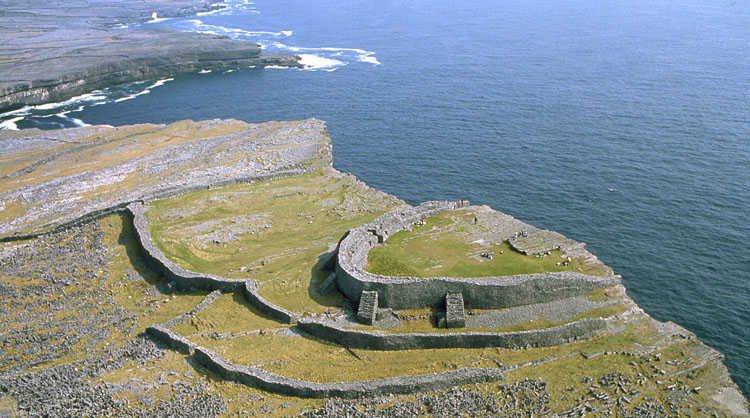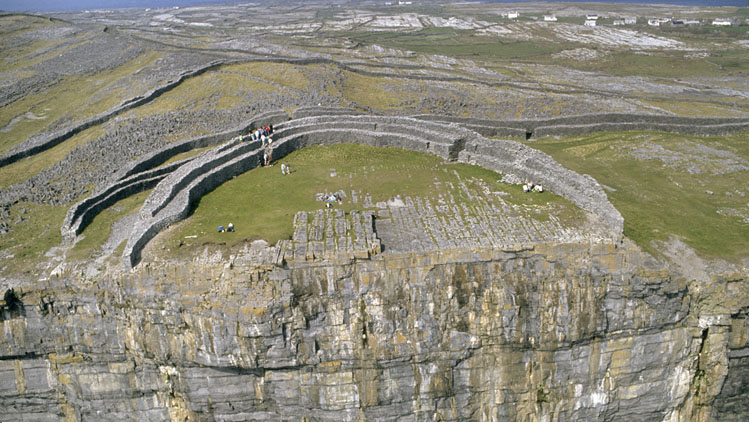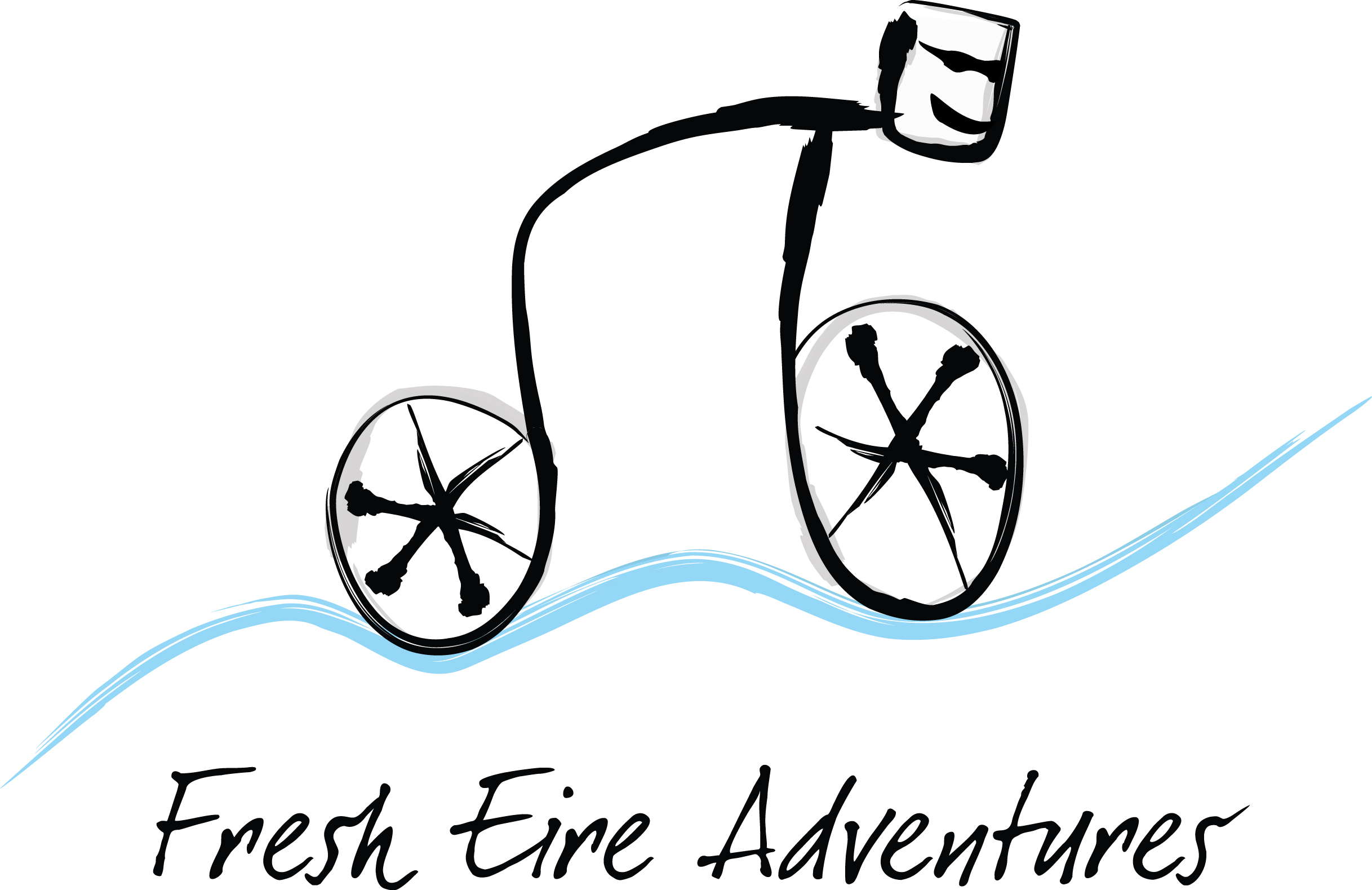Aran Islands – Inis Mhór day trip from Galway
On the West coast of Ireland you can find the Aran Islands. Inis Mhór, which means the big island, has a lot of things to offer most notably Dun Aonghasa described below. Inis Meain, the second largest of the islands and home to Ferboy's Fort, Conor's Fort, Saint Kenderrig's grave, dramatic cliffs and beautiful beaches. Inis Oirr, at 3km x 3km, is the smallest of the Aran Islands but very distinctive in its own right, boasts white sandy beaches, views of the Cliffs of Moher and the Plassy shipwreck are among its key features.
There are two ways to get to Inis Mor, by boat or by plane. From Galway, the boat of Aran Island Ferries will take you there by way of a bus shuttle to the ferry port of Rosaveal. Travelling by plane will result in a return ticket with Aer Arann Islands. Both give a different perspective and point of view of the big island. Once you set foot on the island, you can rent a bike and cycle around the island.
Dun Aonghasa daytrip from Galway
Who Angus was is unknown. According to legend, Aonghus belonged to a high-ranking dynasty who were displaced from their lands in Co. Meath in the early centuries AD. Another possible candidate, is Aonghus Mac Natfráich, King of Cashel in the 5th century AD, who had dynastic affiliations with Aran.
Who Angus was is unknown. According to legend, Aonghus belonged to a high-ranking dynasty who were displaced from their lands in Co. Meath in the early centuries AD. Another possible candidate, is Aonghus Mac Natfráich, King of Cashel in the 5th century AD, who had dynastic affiliations with Aran.

Recent excavations by a team from The Discovery Programme found evidence for human activity on the hilltop stretching over two and a half thousand years (c. 1500BC – 1000AD). First enclosed ca. 1100BC, the most dynamic period in the history of this hillfort was around 800BC. At that time, Dún Aonghasa was probably the political, economic and ritual centre for a group of people with a common ancestry. Only the elite members of this group would have lived in the fort. After 700BC, the importance of the site waned and, over the following thousand years, it seems to have been occupied only intermittently. A major rebuilding programme was undertaken in the Early Medieval period (500 – 1000AD) but the fort was abandoned shortly afterwards. Dún Aonghasa became a National Monument at the end of the 19th century and was extensively repaired shortly afterwards. It is now conserved by the Office of Public Works.
The Late Bronze Age Hillfort
Covering an area of 5.7 hectares (14 acres), the interior of the hillfort is divided into an outer, middle and inner enclosure by three curvilinear walls terminating at the cliff. An additional stretch of wall runs along west side and, when the fort was occupied, there was probably a ‘safety wall’ along the cliff-edge. Outside the middle closure is a broad band of chevaux de frise (closely-set stone pillars) that even today are difficult to negotiate.
Covering an area of 5.7 hectares (14 acres), the interior of the hillfort is divided into an outer, middle and inner enclosure by three curvilinear walls terminating at the cliff. An additional stretch of wall runs along west side and, when the fort was occupied, there was probably a ‘safety wall’ along the cliff-edge. Outside the middle closure is a broad band of chevaux de frise (closely-set stone pillars) that even today are difficult to negotiate.
The original approach to the fort was from the north and the main entrances through the outer and middle walls face in this direction. Today, the entry point is through a breach in the outer wall, but the original doorway can be seen at some distance to the right.
Middle Enclosure
The original doorway to the middle enclosure, about 50m to the right of the present entrance, is now blocked up because of the poor condition of the roof lintels. The entrance would have been closed off by a wooden gate and the sudden drop inside the threshold was probably designed to trip any unwanted visitors. The bodies of two young men were interred in the paved entrance around 1000AD. These may have had Viking connections but there was no evidence to suggest that they died violently.
Inner Enclosure
The inner enclosure wall measuring 5m in width, was built up in layers so that the foundations could be stepped over rising ground. Originally, it was probably about 6m high and ca. 6500 tonnes of stone were used in its construction. The terrace on the interior gave access to the wall top and the small chamber in the west side of the wall may have been used for storing precious or perishable goods.
The inner enclosure wall measuring 5m in width, was built up in layers so that the foundations could be stepped over rising ground. Originally, it was probably about 6m high and ca. 6500 tonnes of stone were used in its construction. The terrace on the interior gave access to the wall top and the small chamber in the west side of the wall may have been used for storing precious or perishable goods.
Lifestyle
The stone foundations of seven houses were found in the inner enclosure. The floors were paved and a number had a stone hearth. The outline of a circular house, ca 5m in diameter, is still visible near the west wall. Its foundations are partly covered by the enclosing wall, indicating that the house predates the final alterations to the defences. A stone trough the outside door was probably used either for storing water, keeping shellfish fresh or for boiling meat using the hot-stone cooking method. In addition to meat and cereals, fish and shellfish were an important part of the diet of the Late Bronze Age occupants. Almost 8 tonnes of limpet shells were found during the excavations. Most of the tools in everyday use (hammers, axes, whetstones and quern stones) were made from stone. Clothing was made from wool or leather and fastened with bone pins; the range of needle types found also showed that the Late Bronze Age people used a wide variety of organic materials.
The stone foundations of seven houses were found in the inner enclosure. The floors were paved and a number had a stone hearth. The outline of a circular house, ca 5m in diameter, is still visible near the west wall. Its foundations are partly covered by the enclosing wall, indicating that the house predates the final alterations to the defences. A stone trough the outside door was probably used either for storing water, keeping shellfish fresh or for boiling meat using the hot-stone cooking method. In addition to meat and cereals, fish and shellfish were an important part of the diet of the Late Bronze Age occupants. Almost 8 tonnes of limpet shells were found during the excavations. Most of the tools in everyday use (hammers, axes, whetstones and quern stones) were made from stone. Clothing was made from wool or leather and fastened with bone pins; the range of needle types found also showed that the Late Bronze Age people used a wide variety of organic materials.

Ritual
The rock platform at the cliff edge may have had a ritual or ceremonial function and a hoard of four bronze rings deliberately buried beside it was probably an offering to a deity. At the opposite end of the inner enclosure, a large hearth seems to have been associated with communal feasting and with the casting of bronze weapons and tools.
The rock platform at the cliff edge may have had a ritual or ceremonial function and a hoard of four bronze rings deliberately buried beside it was probably an offering to a deity. At the opposite end of the inner enclosure, a large hearth seems to have been associated with communal feasting and with the casting of bronze weapons and tools.
